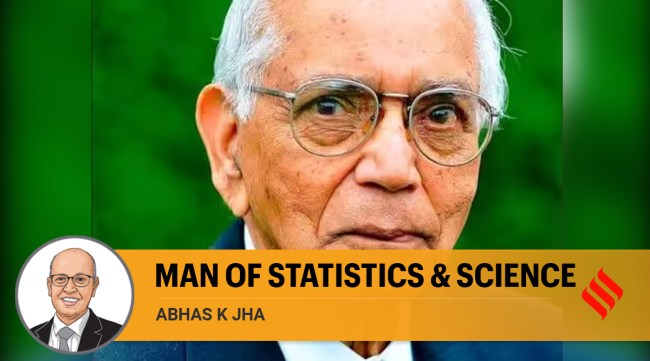Opinion Remembering C R Rao: Man of statistics and science
His life story encapsulated mathematics's beauty and power to reveal theoretical and practical insights
 Born in 1920 in a small village in Andhra Pradesh, Rao displayed mathematical aptitude from an early age.
Born in 1920 in a small village in Andhra Pradesh, Rao displayed mathematical aptitude from an early age. “PLAY in everyone’s backyard,” John Tukey, a mathematician, once said of statistics. Calyampudi Radhakrishna Rao did just that. His pioneering work over eight decades transformed the analysis of data in fields as varied as economics, genetics, anthropology and medicine.
It was the mark of Rao’s genius that he created statistical tools with wide applicability. The Cramer-Rao bound, which he formulated in 1945, provides a lower limit on the variance of any estimator. It gives researchers a benchmark for assessing new techniques. Rao-Blackwellisation, conceived with David Blackwell in 1948, shows how to construct a more efficient estimator by exploiting additional information. Orthogonal arrays, which Rao introduced in 1947, offer an efficient way to structure experiments measuring the effects of various inputs.
These breakthroughs barely scratch the surface of Rao’s astonishing contributions. He published around 500 papers and 14 books addressing knotty statistical problems. His awards include the Guy Medal in silver (1965) and gold (1993) from the Royal Statistical Society. India awarded him the Padma Vibhushan in 2001; and America its National Medal of Science in 2002.
His direct academic descendants (‘Rao’s children’) number over 50 and span the globe. Their tributes speak to his generosity, humility, and passion for statistics. Rao’s life emblemised how rigorous, creative mathematics could unlock nature’s secrets and benefit human welfare. The backyard has lost its most distinguished guest.
Born in 1920 in a small village in Andhra Pradesh, Rao displayed mathematical aptitude from an early age. He obtained degrees in statistics from the University of Calcutta and Cambridge before starting his prolific research career. Positions at the Indian Statistical Institute, the University of Pittsburgh and Pennsylvania State University provided fertile ground for breakthroughs.
Rao’s work on multivariate analysis, estimation theory, and differential geometry proved particularly influential. The Fisher-Rao metric, named for Rao and Ronald Fisher, finds wide use in probability theory and physics. Rao coined the term “differential geometry” in the statistical context, recognising parallels with Einstein’s work on curvature.
Applications of Rao’s innovations spread rapidly across disciplines. In econometrics, the Rao-Zyskind model improved estimates of consumer demand based on limited data. Biologists employ Rao’s score test to detect genetic associations. Geologists use Rao-Blackwellised estimates to date the ages of rocks.
The unifying theme of Rao’s research was a focus on efficient, optimal methods for gleaning insights from data. His textbook Advanced Statistical Methods in Biometric Research, published in 1952, influenced generations of statisticians. The Rao-Blackwell theorem, showing how to improve crude estimates, is a staple of statistics curricula today.
In later decades, Rao turned his attention to newer statistical challenges posed by genetics, neuroscience, and machine learning. He recognised sooner than most the potential for computers to automate and enhance statistical analysis. His work on sequential learning algorithms laid the foundations for modern artificial intelligence.
Rao’s enthusiasm and humility won him affection as well as renown. He supervised over 30 PhD students, many of whom became leading lights. They recall his generosity with ideas, his passion for seeking unknown truths hidden in data, and his gentle encouragement to tackle difficult problems.
Though Rao’s heart remained in India, his influence spread across the world. He served as president of the International Statistical Institute, American Statistical Association and International Biometric Society, among other roles. The Committee of Presidents of Statistical Societies named their award for outstanding research in Rao’s honour in 2012.
As a proud Indian, Rao also nurtured statistics and science in his homeland. He founded the Indian Econometric Society and helped establish the Indian Statistical Institute as a world-class research centre. Generations of Indian statisticians owe their careers to his pioneering institution-building.
Rao’s life story encapsulates mathematics’s power and beauty to reveal theoretical and practical insights. His research elucidated the foundations of statistical theory even as it enabled new discoveries in the sciences. And his generosity as a teacher ensured that the benefits spread widely. Statistics has lost its most illustrious expositor and one of India’s most accomplished scientists. But Rao’s legacy endures in the myriad fields advanced by his pathbreaking ideas. Though he has passed, the enduring impact of C R Rao’s statistical backyard play will continue for generations.
The writer is with the World Bank. Views expressed are personal





